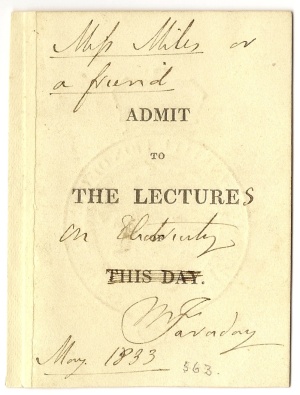I cannot resist saying to any young techies who might be reading this, “No, it is not Steve Jobs at Apple Computer in Cupertino, California!” There, I did it. Nor is it Thomas Edison, that well-known and prolific inventor working in New Jersey at the turn of the 19th century who can claim the title, “Father of the Electrical Age.”
Michael Faraday from London, England rightfully deserves that honor…and much more. Faraday was the greatest experimental physicist of all time, and a first-class chemist as well during a period when the sciences of chemistry and electricity were still in their infancy. His laboratory (and place of residence) for the years 1813 to 1862 was the unique Royal Institution of Great Britain, one of the first organizations dedicated to professional scientific research and to the dissemination and application of science – for the benefit of society.
Founded in 1799 at 21 Albemarle Street in the fashionable Mayfair District of London, it is still there today – in the very same building! It remains an important player in the international scientific scene.
As amazing as that may seem, the story of Michael Faraday is even more incredible.Coming from a childhood of poverty in London and a family background steeped in the trades and poorly educated, young Faraday was apprenticed at age twelve to a Mr. Ribeau, a London bookbinder. Seemingly headed down the same path of life as the generations in his family who came before him, young Michael learned the bookbinding trade and supported his widowed mother throughout his teen years. By taking the initiative to read portions of the many scientific tomes brought by wealthy Londoners to be fashionably bound for their libraries, young Faraday’s curiosity about the physical and natural world burgeoned, instilling a burning desire to eventually acquire a “position” somehow connected with science – any position!
The Incredible Ascent of Michael Faraday: Fact IS Stranger Than Fiction!
If true stories about people overcoming incredible odds and achieving great results fascinate you, I suggest that the story of Faraday’s ascent to international scientific renown and his lasting influence on science – and our lives today – cannot be topped. Please read on.
In 1812, a wealthy, well-connected Londoner and an original life-time subscriber to the then-fledgling Royal Institution bestowed an act of kindness which would dramatically change Faraday’s life and the path of science itself. As a frequent patron of Mr. Ribeau’s bookbinding shop, George Dance developed a liking for the earnest, industrious young Faraday. He presented young Michael with tickets to a series of four scientific lectures at the prestigious Royal Institution, to be delivered by the premier young chemist of the time, Sir Humphry Davy, a member of the Institution’s small staff. Davy’s brilliant lectures always attracted a full-house – a mix of scientific types and the “nouveau learned” among London’s fashionable set, anxious to at least taste and rub elbows with the latest developments in science.
Young Faraday devoured the lectures making copious notes and diagrams of all the fine points. He proceeded to professionally bind these into a thick volume which he sent to Davy along with a letter introducing himself and declaring “My desire to escape from trade, which I thought vicious and selfish, and to enter into service of Science, which I imagined made its pursuers amiable and liberal…” Davy, impressed by the young man’s initiative, wrote back, and, in Faraday’s own recounting, “He smiled at my notion of the superior moral feelings of scientific men and said he would leave me to the experience of a few years to set me right in the matter.” Davy had obviously come face-to-face with the less altruistic aspects of a career in science during his own recent, very rapid rise to fame. His warnings to young Faraday proved disappointingly appropriate as we shall see shortly.
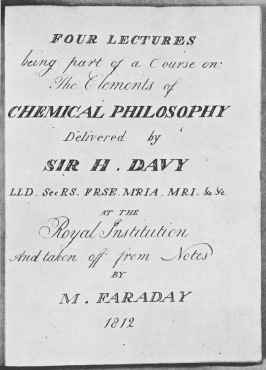 Faraday’s Presentation Notes on the Davy Lectures
Faraday’s Presentation Notes on the Davy Lectures
In January of 1813, the position of laboratory assistant at the RI became vacant, and Davy gave Faraday the job after interviewing him at the Royal Institution in February. Faraday was thrilled to be working with the great Sir Humphry Davy even though the title of “lab assistant” was much closer to “bottle/test-tube washer and general gofer” than true research assistant. After all, although bright and ambitious, Faraday had but several years of grade-level schooling, and no mathematics or scientific training whatsoever.
The Lowly Caterpillar Morphs Into a Scientific Butterfly
![800px-M_Faraday_Lab_H_Moore[1]](https://reasonandreflection.files.wordpress.com/2013/08/800px-m_faraday_lab_h_moore1.jpg?w=300&h=160)
Faraday at Work in His Early RI Laboratory
Within several short years from his humble beginnings, Faraday was doing his own important, original research in chemistry and the relatively new science of electricity while building himself a growing scientific reputation for skill and ingenuity in the laboratory. In one of the great sorrows of science-history, his former superior and mentor, the great Davy, somehow felt personally threatened by Faraday’s absolutely unpredictable ascent into Davy’s scientific stratosphere. He tipped his hand by being the only voting member to register a blackball against Faraday’s proposed membership to The Royal Society of London, the most prestigious scientific body in the world – at one time presided over for many years by the great Isaac Newton, himself. Davy thoroughly respected Faraday and his hard-earned credentials; his only apparent reason for the blackball stemmed from his belief that Faraday had somewhat plagiarized a colleague’s work on “electromagnetic rotations” – the first working electric motor. The facts are fuzzy as often happens in cases of scientific priority, but as ambitious as Faraday was scientifically, he was scrupulously honest, maintaining his humble demeanor despite his escalating fame and reputation. For all his genius, Davy had his quirks.
The history of this sad event contrasts, in stark relief, the polar opposite personalities of the mercurial, proud, and ego-centric Davy as compared with the steady, humble and gracious Faraday – “the saint of science” if ever there was one. Sadly, Davy may have known himself all too well when he cautioned Faraday earlier about the notion of “superior moral feelings” where the practice of science is concerned. Faraday took the unwarranted blackball from Davy stoically, always preferring to remember Davy to others as the great scientist he was and the man who gave life to Faraday’s dreams and talent. Davy’s colorful life and story warrant a separate blog post of its own, and, because I have studied them both extensively, I will probably write one.
Despite Davy’s numerous and important contributions to science, it has been said that his greatest discovery was Michael Faraday! Who could argue?
What Were Faraday’s Contributions to the Fledgling Science of Electricity?
Here is the succinct answer: He demonstrated in 1821 how to convert electrical energy into the mechanical energy of motion – the first working electric motor; in 1831, he showed how to convert the mechanical energy of motion into electrical energy – the electric generator! The experiment connected with the first practical electric generator (which he built) was conducted by Faraday in 1831, and is known as his discovery of electromagnetic induction – the principle of the ubiquitous electrical transformer. Basically, the transformer is a pair of physically separate, mutually-unconnected coils of wire wound on a common iron core. When electrical current changes in one of the coils, a voltage is generated in the second coil and an electrical current results if that coil is part of a closed electrical path. Note that I underlined current changes, above, for no voltage is induced in the second coil when the current in the first is held constant. It was Faraday’s insight and experimental genius that allowed him to make that critical observation after so many researchers, including himself, had failed by merely looking at the steady-state effects of an applied current. The reason we have AC (alternating voltages and currents) and not DC (direct, or constant voltages and currents) supplied to our homes is due to our ability to transform them up and down in level for efficient power transmission and distribution using transformers which operate on Faraday’s law of electromagnetic induction.
I have the actual 1831 printing of his scientific paper which appeared in the Philosophical Transactions of The Royal Society. For the layman, Faraday’s findings sound mysterious, though rather simple, but their ramifications form one of the bedrock pillars not only of our electric power distribution systems, but also of the great technologies which have historically stemmed from the geniuses at Bell Labs, RCA, IBM, and countless high-tech companies domiciled here in Silicon Valley, California and elsewhere.
Faraday’s Transformer
Faraday’s Diary Entry of Aug. 29, 1831
The true measure of Faraday’s genius is the fact that he did not stop there. He wondered about the mysterious, non-physical coupling between the two coils of wire. How can a changing current in one create a voltage/current in the other when they are electrically isolated from one another? To answer that, Faraday postulated a conditioning of space, a vision of invisible electric and magnetic “fields” in “empty” space which serve to electrically couple the two coils together. This daring leap into unknown territory was the lead which prompted another great physicist, the Scotsman James Clerk Maxwell, to deduce Maxwell’s equations which today are four in number. These describe mathematically and quantitatively, the actual electric and magnetic field characteristics which are the basis of all electromagnetic propagation, including radio waves and that most ubiquitous of all electromagnetic propagation, visible light itself. The only fundamental difference between radio waves, X-rays, visible light, and the signals propagated to and from your cell phone is the frequency of electromagnetic “vibration.”
All right, enough already! I can sense the glaze-over effect surfacing in some of you. I understand, but I did want to impart more than merely a handful of technological buzz-words to you, my faithful readers who have come this far.
Unlike Faraday who so keenly penetrated the natural world knowing essentially no mathematics whatsoever, Maxwell was a well-educated physicist/mathematician; his work on electromagnetics during the 1860’s was truly the foundation for ALL and I do mean ALL of our communications technology. His mathematical prediction of propagating transverse electromagnetic waves through space in 1865 (radio, in essence) predated the first experimental verification of such in 1887 by Heinrich Hertz.
Although Faraday could not possibly follow the vector calculus formulated by Maxwell to describe electromagnetic phenomena, it was Faraday who came up with the initial concept of “lines of electric and magnetic force” in space which Maxwell went on to describe and quantify mathematically.
Maxwell met Faraday when the great man was in his last years to show his great respect, graciously giving him credit as the ground-breaker for the magnificent edifice that Maxwell ultimately erected. Maxwell’s name, like Faraday’s is little-known outside of science and engineering….but those two individuals have impacted society –indeed civilization – in profound ways, ways too numerous to list.
I first saw them there in 1979 while attending a week-long engineering seminar, and I was thrilled. Along the upper carapaces of the imposing buildings of the Massachusetts Institute of Technology at Cambridge, Massachusetts, one sees the names of scientists chiseled in appropriately bold letters. EINSTEIN, NEWTON, DARWIN, MAXWELL, and, yes, FARADAY are prominently visible there. They, and the others emblazoned and honored there, were the truly great ones – the immortals.
Perhaps the ultimate endorsement of Faraday’s place in science is the fact that, at one time, three scientific portraits hung in Albert Einstein’s study: Newton, Maxwell, and Faraday.
As prolific and important as Thomas Edison’s inventions were to the harnessing of electricity and the development of the electrical age, he was an inventor/technologist, not a scientist. It is absolutely certain that without the scientist’s grasp of nature’s laws, there can be no real technology. Great inventions are drawn from great discoveries in science.
As for hands-on ability in the laboratory: Despite his great abilities, Edison would surely take a back seat to Faraday, the world –class physicist who did it all without the aid of mathematics by relying on superb intuition and powers of observation. In tribute to his lab technique and experimental skill, I would wager that Faraday broke few test tubes and other pieces of apparatus during those many years in the laboratory. Stories abound of otherwise great scientists who were decidedly unwelcome in the laboratory because they broke everything they touched!
Finally and fittingly, Michael Faraday, who worked and lived with his wife in the house of the Royal Institution for fifty-one years, continued almost seamlessly the great public lecture tradition begun there by the brilliant Davy in 1802. Faraday’s lectures on a great myriad of scientific subjects are legend; his lecturing style in the great lecture hall was unique. The public and the intelligentsia of science flocked there to hear him speak …and to learn. I have an admission ticket to his May,1833 RI lectures on electricity, endorsed by Faraday himself and addressed to “Miss Miles or a friend.”
One of his best-known lectures was among his last, part of the annual Christmas Lectures delivered by Faraday around Christmas time, 1860 when he was in his seventieth year, near retirement, and already suffering from loss of memory. Published in March, 1861, The Chemical History of a Candle has been continuously in print (in English) since that time. It has long been considered a classic in popular science exposition; in its pages, Faraday analyzes the physical and chemical combustion processes of a burning candle in terms that even the scientific neophyte can understand…and enjoy.
If I have piqued your interest and curiosity with this post, and you would like to better understand how a scientific virtuoso such as Faraday views nature, expressed in terms suitable for his “popular” lectures, take a look at this little book. I just purchased a nicely printed new edition from the Oxford Press. There is a good reason for its longevity in print.

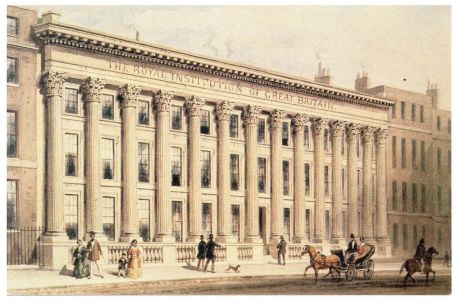
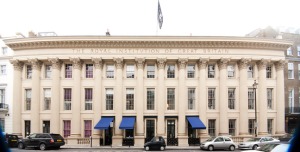
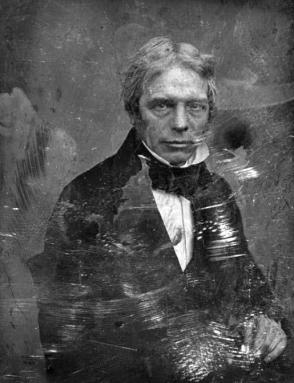
![Humphry-Davy-5[1]](https://reasonandreflection.files.wordpress.com/2013/08/humphry-davy-51.jpg?w=300&h=265)

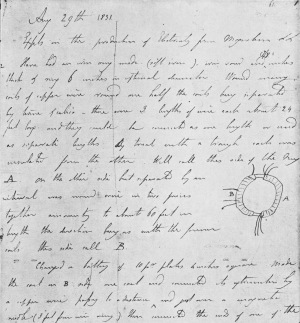
![1208029030_james_clerk_maxwell_big[1]](https://reasonandreflection.files.wordpress.com/2013/08/1208029030_james_clerk_maxwell_big1.jpg?w=300&h=282)
